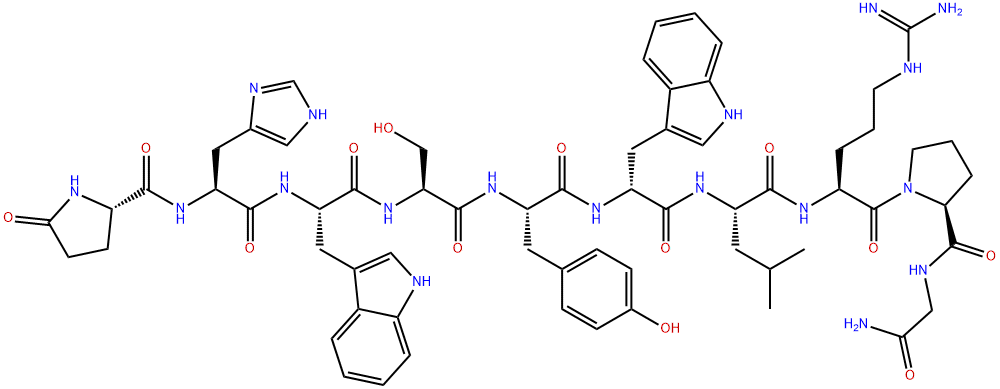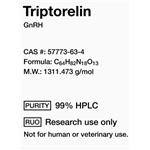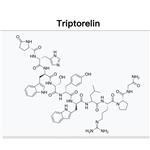Antineoplastic drug
The active ingredient of triptorelin is a synthetic gonadotropin-releasing hormone (GnRH) analogue, which is also known as decapeptyl, diphereline, triptorelin acetate, gonadorelin. It is an antineoplastic drug, whose pharmacological effects are same with goserelin, buserelin, and its structure is modified by natural molecular structure of the sixth L-glycine that is replaced by D-tryptophan to promote efficiency and prolong the plasmic half-life time, as well as enhance drug efficacy. After intramuscular injection, it initially stimulates the pituitary gland to release luteinizing growth hormone (LH) and follicle-stimulating hormone (FSH). When the pituitary over a long period of stimulation will be into the refractory period, that reduced the release of gonadotropin, leading to sex hormones reduction to castrate levels. These effects are reversible. Subcutaneous administration is rapidly absorbed, and Tmax is 15min, and the effect is maximum at 1h. The intramuscular injection of sustained release formulations can maintain the efficacy reaching 28d or more. It Clinically uses for the treatment of endometriosis, hormone-dependent prostate cancer, breast cancer, precocious puberty, as well as it may also be used as assisted reproductive technology. The main side effects of triptorelin are as follows: In the early stage of treatment of male, it can cause urinary disorders, breast swelling and pain, bone pain, and it may also cause hot flashes, loss of libido and impotence. It rarely cause gynecomastia, testicular atrophy, and sleep disorders. In the first week of treatment for children, girls will occur small amount of vaginal bleeding, which can be corrected by short-term additional therapy. During the treatment of women, hot flashes, bleeding or bleeding spots, vaginal dryness, headaches and weakness can occur. It can cause abdominal and (or) pelvic pain when it uses combination with gonadotropin. Since the concentration of estrogen reduces to the level of post-menopause, it can cause slight loss of trabecular bone matrix. Generally, after cessation of treatment six to nine months the adverse reations can return to normal. There may be irreversible amenorrhea after treatment in patients with endometriosis.
The above information is edited by the chemicalbook of Kui Ming.
Description
Decapeptyl is a modified (D-Trp
6) LH-RH. Like recently marketed buserelin and
leuprolide (I), it is useful in achieving medical castration in the treatment of advanced prostate cancer.
Originator
Tulane Univ. (USA)
Uses
Triptorelin is a GnRH agaonist shown to inhibit estradiol-induced cancer cell proliferation.
Uses
[D-Trp6]-LH-RH (luteinizing hormone releasing hormone) has been used to study whether the (M
. – X) region in electron capture dissociation provides information on amino acid composition of polypeptides. It is also used to study the effect of LH-RH on the production of progesterone (P), estradiol (E2) or human chorionic gonadotropin (hCG) by JEG-3 choriocarcinoma cells.
Definition
ChEBI: An oligopeptide comprising pyroglutamyl, histidyl, tryptophyl, seryl, tyrosyl, D-tryptophyl, leucyl, arginyl, prolyl and glycinamide residues joined in sequence. It is an agonist analogue of gonadotropin-releasing hormone.
brand name
Trelstar (Watson).
Biochem/physiol Actions
Potent LH-RH agonist with enhanced biological activity due to its slower rate of degradation. Like [D-Lys6]-LH-RH, the D-Trp6 analog has been shown to be effective against cancers expressing the LH-RH receptor. However, unlike the D-Lys6 analog, it is generally used in the unconjugated form.
Clinical Use
Triptorelin pamoate is another superagonist of GnRH, which like nafarelin acetate contains only
a single amino acid substitution (D-Trp6 for Gly6) when compared to the natural hormone. In the treatment of advanced prostate cancer, it is important to reduce serum
testosterone levels to very low levels, which can be achieved surgically by orchiectomy. When
this surgical method is unacceptable to the patient, an alternative approach is “chemical
castration,” which can be achieved by use of estrogen therapy, leuprolide,goserelin or histrelin acetates, and now, triptorelin pamoate. This product is available for IM
depot injection (monthly or every 3 months), wherein serum testosterone concentration drops to
a level generally seen in surgically castrated men.
Side effects
The side effects of Triptorelin: Painful or difficult urination, burning when you urinate, blood in the urine; bone pain; (in children) new or worsening signs of puberty; a seizure; chest pain or pressure, pain spreading to your jaw or shoulder; sudden numbness or weakness, slurred speech; increased pressure inside the skull - severe headaches, ringing in your ears, dizziness, nausea, vision problems, pain behind your eyes; loss of movement in any part of your body; high blood sugar - increased thirst, increased urination, hunger, dry mouth, fruity breath odor; or nerve problems - back pain, muscle weakness, problems with balance or coordination, severe numbness or tingling in your legs or feet, loss of bladder or bowel control.
Metabolism
The metabolism of triptorelin in humans is unknown, but
it is thought to be hydrolysed in the plasma and excreted
in the urine as inactive metabolites.
Mode of action
Triptorelin is a gonadotrophin releasing hormone (GnRH) blocker. This means it stops messages from a part of the brain called the hypothalamus that tells the pituitary gland Open a glossary item to produce luteinising hormone. Luteinising hormone tells the testicles to produce testosterone Open a glossary item. So, blocking GnRH stops the testicles producing testosterone. Prostate cancer depends on testosterone to grow. So triptorelin can shrink the cancer or slow its growth. In women, it stops the ovaries Open a glossary item from producing oestrogen. Some breast cancers depend on oestrogen to grow. Lowering the level of oestrogen can slow or stop the growth of the cancer.




